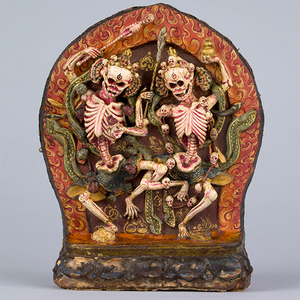
The Rubin Museum of Art will present "Death Is Not the End," a new exhibition opening September 18 that explores notions of death and the afterlife through the art of Tibetan Buddhism and Christianity. Featuring prints, oil paintings, bone ornaments, thangka paintings, sculptures, illuminated manuscripts, and ritual items, "Death Is Not the End" invites contemplation on the universal human condition of impermanence and the desire to continue to exist. This cross-cultural exhibition brings together over 30 objects spanning 12 centuries from the Rubin Museum's collection alongside artworks on loan from private collections and major institutions including the Metropolitan Museum of Art, Morgan Library and Museum, Museum aan de Stroom in Antwerp, Wellcome Collection in London, Nelson Atkins Museum in Kansas City, and more. "Death Is Not the End" is part of the Rubin Museum's yearlong thematic exploration of impermanence, a fundamental principle in Buddhist philosophy, and will be on view from September 18, 2020, to February 8, 2021.
Buddhist and Christian cultures share the certainty of our mortality in this world while also proposing an existence after this lifetime. Depending on the circumstances, there is a promise of a better place, or one of further purifying suffering to ensure the eventual attainment of a better existence. These views, in their most general sense, refute the permanence of death while accepting its inevitability. "Death Is Not the End" considers the ideas that balance this apparent contradiction.
The exhibition will be organized around three major themes: The Human Condition, or the shared understanding of our mortality in this world; States In-Between, or the ideas of limbo, purgatory, and bardo; and (After)life, focusing on resurrection, ideas of transformation, and heaven. Each section will include areas where visitors can listen to select anonymous voices reflecting on death and the afterlife, inviting visitors to contemplate these ideas on a more personal level.
Notable artworks on view from the Rubin Museum's collection will include The Wheel of Life painting (Tibet; 19th century), which illustrates the larger context of human existence, the causes of suffering, and the inevitability of death and rebirth; the Yama Dharmaraja painting (Tibet; 18th century), which depicts a wrathful deity associated with Vajrabhairava, conqueror of death; the painted terracotta sculpture Lords of the Charnel Ground, Smashana Adipati (Tibet; 18th century), featuring dancing skeletons, protectors of tantric yoga practices who celebrate freedom from attachment; Avalokiteshvara and His Pure Realm (Tibet, late 18th-early 19th century), which presents the realm where beings aspire to be reborn, to be in the presence of the deity; and more.
Works on loan will include the unattributed painting A Woman Divided into Two Representing Life and Death (ca. 18th century; Wellcome Collection), which is an allegorical depiction of the human condition; Pietro Perugino's The Resurrection (Italy; early 16th century; Metropolitan Museum of Art), which expresses Christ's victory over death and God's glory; Pieter van der Heyden's engraving of The Descent of Christ into Limbo, after Pieter Bruegel the Elder (Netherlands; ca. 1561), which illustrates Christ appearing in a sphere of radiance, guiding souls that are crowding out of the hellish mouth of limbo and into heaven; a Buddhist album leaf painting illustrating Beings Liberated from Hell by the Blessings of the Buddha (Inner Mongolia; 18th-19th century; Museum aan de Stroom, Antwerp), which depicts another instance of "divine intervention" by Buddha Vairochana; and more.
In conjunction with this exhibition, the conversation series The Tibetan Book of the Dead Book Club will take place in the Rubin Museum theater on the following Monday evenings: October 5, October 19, October 26, November 9, November 16, and November 23. For each session a leading bardo scholar and a specialist from a different field will select a passage from the Tibetan Book of the Dead, an important ritual text that guides the dying through the transitory state into rebirth and liberation.
"Death Is Not the End" is curated by Elena Pakhoutova, Curator of Himalayan Art at the Rubin.
In 2020 the Rubin's exhibitions, programs, and experiences are unified in exploring the concept of impermanence. Drawing on a diverse range of sources and perspectives - from contemporary art to scientific theories to Buddhist philosophies - the Rubin will explore the freedom and ease that comes from accepting change and consciously living in the present.
Elena Pakhoutova is Curator of Himalayan Art at the Rubin Museum of Art with a PhD in Asian art history from the University of Virginia. Her background in Tibetan Buddhist studies contributes to her interdisciplinary approach to art history. Her research explores dialogues in the visual traditions of Inner Asia, art and ritual, art production and patronage, text and image, and narrative in Tibetan visual culture. Her other interests include cross-cultural exchange, material culture, and contemporary Tibetan art. At the Rubin Museum, she has curated several exhibitions, including "Collecting Paradise: Buddhist Art of Kashmir and Its Legacies," "Nepalese Seasons: Rain and Ritual," "The All-Knowing Buddha: A Secret Guide" (co-curated with Karl Debreczeny), "The Second Buddha: Master of Time," and most recently "The Power of Intention: Reinventing the (Prayer) Wheel".


